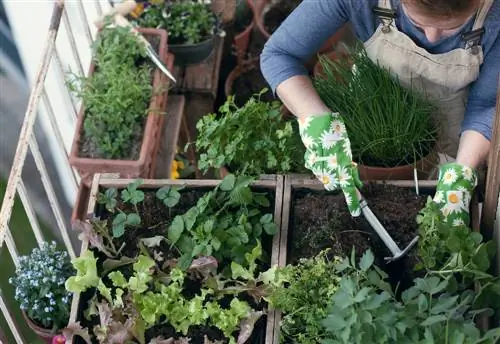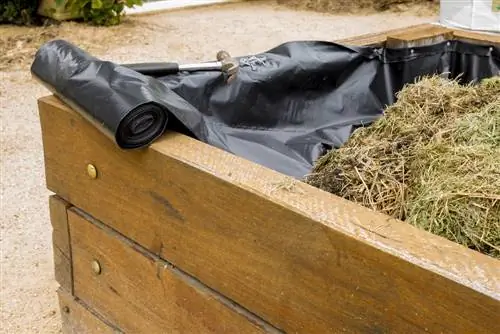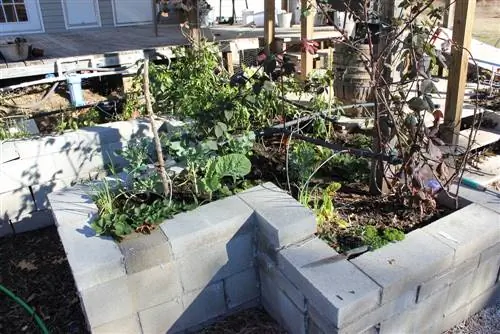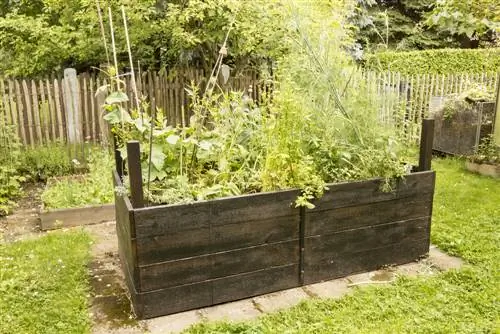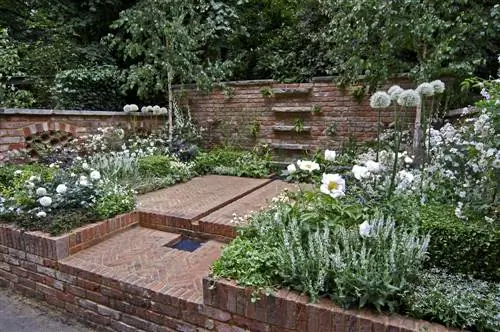- Author admin [email protected].
- Public 2023-12-16 16:46.
- Last modified 2025-06-01 06:02.
Raised beds are booming because they ensure high yields in the smallest of spaces. The sophisticated models are even suitable for balconies. There are a few aspects to consider during construction. Filling and planting should also be carefully thought out so that the effort pays off later.
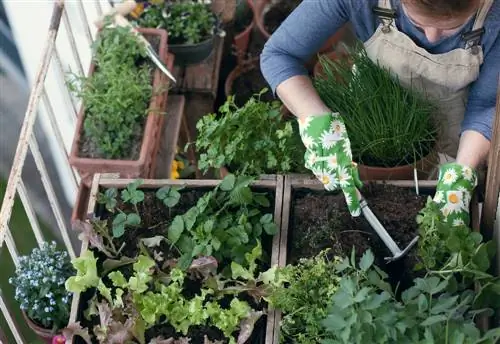
Can you put a raised bed on the balcony?
You build the raised bed for the balcony out of wooden boxes, an old shelf or table. Pay attention to crop rotation. Fill the raised bed with mulch and protect it from drying out. Weight also plays a role, opt for lighter materials.
Building Instructions
The construction of a raised bed for a balcony differs from constructions for the garden in that it has supporting legs. They raise the bed and ensure that the plants are not shaded by balcony railings. For better mobility you can add wheels to the feet.

Wooden box on trestles
Cedar plant boxes are ideal as raised beds. The wood is visually appealing and contains natural cedar oil, which protects against rot, mold and harmful insects. It is also lightweight and sustainable. Choose boxes that are 30 centimeters deep. You can simply attach such plant boxes to two wooden trestles to achieve a comfortable working height.
Repurposing an old table
If you have an old desk with a tabletop resting on a high frame, you can convert it into a raised bed. To ensure that painted or treated wood does not release any toxic substances into the plant substrate, you should line the plant box with harmless foil for safety reasons.
This is what you need:
- Tape measure, hammer, drill, wire cutter and jigsaw
- short nails, fine-meshed wire, drainage fleece
- maybe. Foil for laying out
- thin cedar slats (about four centimeters wide and one centimeter thick)
disused table that is suitable for planting
Construction instructions
Remove the table top so that only the wooden frame and feet remain. Turn the table over and cut the wire mesh to the dimensions of the wooden frame. The wire is attached to the table from below with small nails.
Cut the slats so that they can be placed over the wire mesh as a frame and attached to the table. For better stability, crossbars are installed across the entire surface. Alternatively, you can cover the entire floor with battens. Turn the table over and cut the drainage fleece to the size of the planter box.
Shelf with mini raised beds
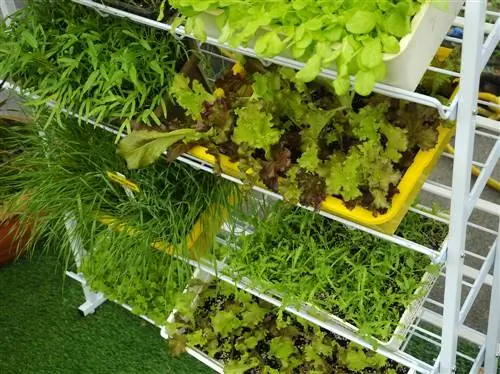
A plant shelf saves space and is practical
If you already have an old bookshelf on hand that is suitable for outdoor location, you can convert it into a vertical raised bed with just a few resources. The shelves are provided with side boards all around, creating a low planter box on each level. Alternatively, you can build a suitable shelf out of Euro pallets and equip it with intermediate shelves.
Many disused pieces of furniture can be converted into a raised bed with a little creativity and craftsmanship.
Small raised bed with cover
You can build a cover for each raised bed and convert the construction into a cold frame. To do this, you need old wooden planks that you saw into two wedges. These wedges are mounted on the two shorter sides of the planter box and serve as spacers for the roof.
A wooden board is attached to the rear long side of the raised bed so that the sloping roof structure is closed at the back. Place a double-wall sheet on the resulting slope. This can be easily cut to the appropriate size with a cutter knife.
How to assemble the roof:
- place the cut double-wall sheet between two wooden plank frames
- connect both frames with nails or screws
- Attach hinges to inner frame
- Attach hinges to the back of the roof support
Material
The material used determines the longevity of the raised bed. Since weight plays a crucial role on the balcony, you should prefer light materials.
Plastic
These variants are particularly light and easy to clean. They are weatherproof and not expensive to buy. The assembly is easy and requires no tools. Many models have a look that is reminiscent of terracotta or wood. There are also space-saving and simple versions that can be covered with a thermal hood. This means that plastic raised beds can be used for cultivation.
However, plastic models have ecological disadvantages compared to natural building materials because they are difficult to recycle. To avoid any he alth risks, the plastic should be colorfast.
Metal
Such designs have a long service life and an unusual design. Metal raised beds are reminiscent of futuristic scenarios. They require less maintenance than wooden models. Depending on the material used, rust protection is recommended. Metal conducts heat better than wood. This brings advantages for cultivation and dangers for adult plants. In summer you need to ensure optimal water supply and ventilation.
- Stainless steel: rustproof, robust and aesthetic
- Corten steel: forms rust, which protects the material from further corrosion.
- Aluminium: light, often with a zinc-aluminum coating
Wood
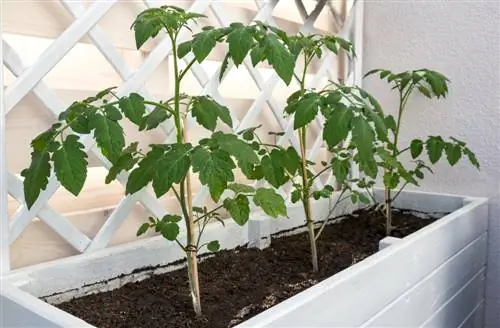
Wooden beds are already available to buy
The natural raw material is renewable and poses no he alth risks if the wood is used untreated. It radiates naturalness and creates a rustic character. A raised bed made of solid wood is very heavy, which is why only thin wood models are suitable for the balcony. They are easier to change. In general, softwoods are more suitable for balconies than hardwoods because of their light weight.
Soft wood is more susceptible to moisture and will weather more quickly without appropriate protection. Despite all protective measures, wood has the least longevity because it is susceptible to pests. You can also build a raised bed out of old pallets, provided the wood does not contain any toxic substances.
| Price Category | Features and special features | |
|---|---|---|
| Pine | cheap | susceptible to moisture |
| Spruce | cheap | light, rots quickly |
| Larch | expensive | very weatherproof and durable |
| Douglas fir | expensive | Avoid contact with the ground |
| Oak | expensive | heavy, very durable |
Other materials
Bed constructions can be built yourself from various materials. If the load-bearing capacity of the balcony allows it, you can use old concrete slabs, grass pavers or gabions. If you have to cover the raised bed with foil, you should avoid PVC. The material often contains toxic plasticizers that can be absorbed by plants. EPDM films made from natural rubber are more suitable.
What should you pay attention to when making a DIY raised bed?
The raised bed on the balcony is a closed living space that needs to be well prepared. Such structures are used for several years without the earth being replaced. Therefore, it is important that you take appropriate precautions and estimate the size correctly.
Size
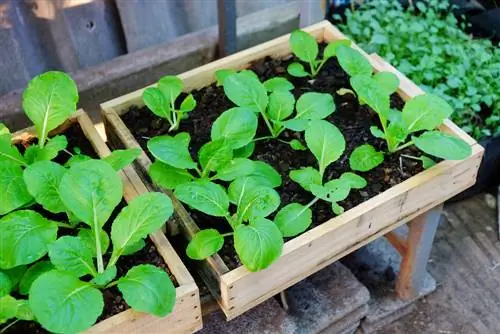
90 cm is a good height for a raised bed
Raised beds are available in standard sizes, with dimensions varying between 70 and 140 centimeters in width and between 70 and 90 centimeters in height. A height of 90 centimeters corresponds approximately to hip height. Such models ensure a back-friendly working posture. The width of the bed construction should not exceed your arm's length so that you can work comfortably and effortlessly. They are relatively flexible in length. You can adapt these to the available space on your balcony.
How deep should the planting insert be?
The depth of the plant insert should be between 30 and 50 centimeters. Shallow-rooted varieties develop their roots to depths of 20 centimeters. Because their roots grow in the upper layers of the soil, these plants require more frequent watering. Middle roots require a depth of 50 centimeters.
- Shallow-rooted: lettuce, onion, radish, spinach, celery, radishes
- Middle-rooted: carrots, beans, kohlrabi, peas, peppers, cucumbers
Ideas and design options
Raised beds with their own floor are suitable for the balcony. Such models can be designed flexibly. Raised beds on wheels are easy to move and provide storage space on the ground. A narrow raised bed that stands directly on the ground can be covered with wooden planks. Small gaps between the boards provide space for rakes and hanging pots.
Drainage
Table raised beds have limited space for filling, which is why space-consuming drainage made of stones is suboptimal. In deeper structures, you can cover the floor with expanded clay. The beads absorb excess water and release it back into the substrate when necessary. If you equip the model with a water drain in the form of small holes on the bottom, rainwater can easily drain away. To avoid unsightly stains on the balcony, you should place a bathtub underneath.
Geotextile
Raised beds without drainage holes can be covered with a special garden fleece made of geotextile. The dense fiber structure stores the water and releases it slowly. If the substrate is too moist, the water can slowly diffuse through the wooden floor and evaporate on the outside.
Purchasing Tips
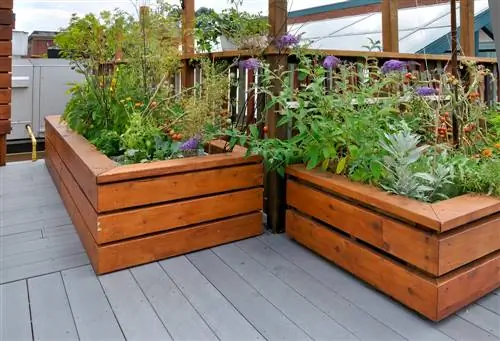
Stable, sufficiently high, weather-resistant and beautiful - a raised bed should combine all of this
The range of raised beds for the balcony is large. Obi, Bauhaus, Dehner and Hornbach as well as Amazon and Ikea offer different models. Cheap raised beds are available at the start of the season from Aldi and Tchibo. If you are new to this type of gardening, you can find out about used products on Ebay and test the possibilities.
Product selection:
- Jewel: Balcony and terrace raised beds made of recycled plastic
- Kubi: designer raised bed made of stainless steel with vertical planting
- Jumbo: raised beds made of wood, metal or plastic with plug-in systems
- Landi: mobile raised beds and plant tables
What should I pay attention to?
A good raised bed should be stable and have some distance from the ground so that cold and frost cannot penetrate from the ground into the plant container. Size and material play an important role and determine the price. If you also want to use the raised bed as a cold frame, you should compare models with a special attachment.
Since the substrate should be completely replaced after a few years, the model design is an important decision point. Plastic tubs can be easily cleaned. Raised beds that are made up of a plug-in system are also practical. Individual elements of these models can be removed, making it easier to replace the soil.
Filling and planting
To maximize the potential of a raised bed, you should fill it correctly. Which soil you use plays just as important a role as the choice of plants. If the raised bed has different soil layers, a natural habitat is automatically created.
Excursus
Why it is warmer in raised beds
In a raised bed the temperature is up to eight degrees higher than in a flat bed. However, the natural decomposition processes only cause a drastic increase in temperature in the substrate for a short time. As soon as the material settles and the air is used up, no new oxygen comes in. Numerous microorganisms cannot continue to work under anaerobic conditions in the soil and slowly die off. However, a raised bed heats up more quickly from the outside in spring because the large outer walls conduct the heat from the sun's rays into the interior.
Conventional layering
In a 50 centimeter high raised bed, the ground is covered with the remains of tree and shrub cuttings. The first layer is about ten centimeters high and is covered with a five centimeter thick layer of grass clippings. Then fill a ten centimeter thick level with biodegradable green waste that has not yet rotted. Another 25 centimeter thick layer of mature compost provides the plants with enough nutrients to grow. In higher raised beds you can adjust the layer thicknesses accordingly.
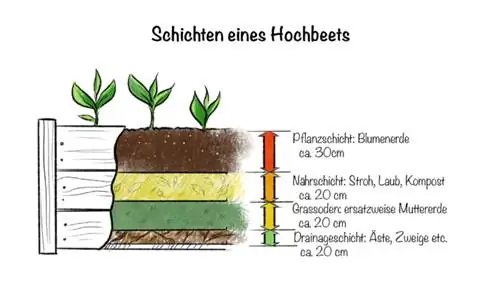
Experimental layering
There are different ways to fill the raised bed. As long as you ensure sufficient nutrient supply, stratification plays a minor role. You can also experiment and cover the bottom of the raised bed with bark mulch. The plant insert is filled with structurally stable soil that has been loosened with lava grit, coarse-grained sand or gravel. Also mix some compost into the soil to meet the plants' nutrient needs.
What the filling has to do:
- high water holding capacity
- low settling and compaction of the material
- functioning habitat for microorganisms
Planting
It is important that you plant the raised bed correctly. This allows you to fully utilize the resources and achieve high returns over several years. The filled raised bed is very nutrient-rich and should be filled with heavy-feeding plants in the first few years. Medium feeders are planted in subsequent years. Weak feeders still thrive in raised beds in the later years. A mixed culture is also ideal so that the plants are not attacked by pests.
| Group | Main plant | Good neighbors | |
|---|---|---|---|
| first and second year | Heavy eaters | Cauliflower | Cucumbers, beetroot, celery |
| third to fourth year | Middle eaters | Carrots | Tomatoes, lettuce, onions |
| fifth to seventh year | Weak eater | Peas | Herbs such as dill, fennel, radishes |
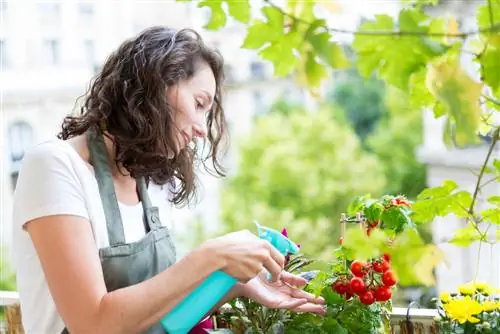
The correct crop rotation must also be observed on the balcony
Taking advantage of heat generation
You can also plant the raised bed according to the natural heat development, so that you benefit from high yields throughout the entire gardening season. The bed gets fuller as the year goes on, so you can harvest fresh vegetables or fruit throughout the season.
Planting plan by month:
- March to April: Spring plants such as arugula, parsley and radish
- End of April: Add spring onions, leeks and onions
- from May: plant early vegetables such as tomatoes, peppers and hot peppers
- in August: autumn salads, kale, endive
- September to October: plant frost-resistant vegetables such as rocket, sprouted broccoli or celery
Tip
If you have harvested everything before winter, you can add fresh nutrients to the soil through horn shavings.
Caring for a raised bed
Raised beds need to be watered sufficiently, especially in summer, so that the substrate does not dry out. You can do without additional fertilizers because you add nutrients to the substrate through annual composting and mulch.
Fill substrate
Over the years, the substrate settles because the microorganisms consume the organic components and convert them into soil. Therefore, you should fill the raised bed again with fresh compost as soon as the soil level has dropped. After six to seven years, the entire substrate should be replaced.
Tip
The used soil is ideal for the garden. Distribute the substrate over vegetable and flower beds.
Mulching
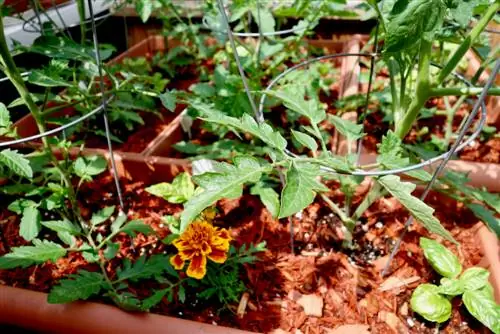
Mulching reduces watering and weeds
This measure is particularly important in raised beds, as the substrate dries out more quickly than in flat beds. The cover also ensures that no unwanted herbs grow. Applied just before winter, the material protects the soil during the frosty season. In spring the plants benefit from additional nutrients. Grass clippings, wood fibers or chopped plants such as nettles or comfrey are suitable as a mulch layer.
Digging
Raised beds are not dug up so that the layering does not get confused. In this way, our own cosmos can develop in which natural processes can take place undisturbed. Before you plant the bed again in subsequent years, the top layer of soil should be loosened slightly.
Frequently asked questions
When should I create my raised bed?
The ideal time is spring, as you can fill the raised bed with plants immediately after filling it. In the fall, a lot of material is produced by cutting trees and lawns, which can be filled into the raised bed. You can also let this grow over the course of a year and top up whenever biodegradable material is available.
Why is the substrate warmer in raised beds?
In the first few weeks after filling, microorganisms work and decompose the biological material. After about four weeks the temperature drops rapidly. Then the oxygen is used up and the microorganisms can no longer live under anaerobic conditions. The fact that the inside of a raised bed is still warmer than the substrate in the flat bed is due to the external heating. The sun shines on the walls, causing the substrate to warm up faster.
Which plants are suitable for the raised bed?
In principle, flowering plants and herbs as well as vegetables and fruit bushes are suitable for cultivation in raised beds. The choice of plants is limited by the climatic conditions in their region. You should also fill the planter with plants whose roots do not reach the ground.
How important is layering in raised beds?
In the raised bed, different materials are layered on top of each other because it is difficult to regulate the water balance and the plants should benefit from the nutrients in the decomposable organic waste. An increase in temperature due to decomposition processes only occurs in the first few weeks. Therefore, conventional stratification does not necessarily have to be maintained.

